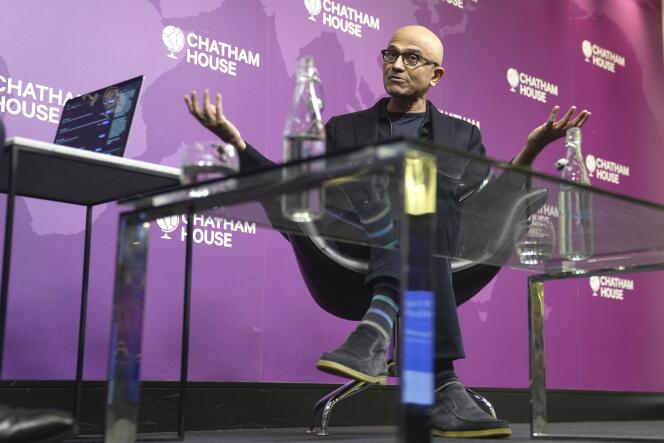


"I was lucky enough to change positions every four or five years. This allowed me to always stay on the alert, constantly motivated," said Satya Nadella, shortly after his appointment as head of Microsoft on February 4, 2014. Ten years later, he has become the steadfast leader of the Redmond-based firm (northwest US), after taking on the role of chairman in June 2021. Until then, only Bill Gates, Microsoft's co-founder in 1975, had worn the hats of chairman and CEO.
Nadella's track record speaks for itself. In January, under the leadership of the 56-year-old Indian, Microsoft became the world's largest market capitalization, surpassing the $3,000 billion (around €2,800 billion) mark, ahead of Apple.
When Nadella took the helm of the tech giant, Microsoft was barely valued at more than $300 million on the stock market and looked like a sleeping beauty living off the enduring success of its Windows operating system and its Office suite of office software. But under Gates' successor, Steve Ballmer (2000-2014), the company missed out on the smartphone revolution, which Apple was quick to fill. The acquisition of Nokia in September 2013 for $7.2 billion did not help the company catch up.
No sooner had he succeeded Steve Ballmer than Nadella led the most massive layoff plan in Microsoft's history, affecting 18,000 jobs (around 14% of the workforce), mainly at Nokia (12,500). Thomas Husson, an analyst at Forrester, noted that "he was able to make strong decisions very quickly to stop the damage." He also highlighted the paradigm shift embodied by the executive born in Hyderabad (India): "Compared with a flashy Ballmer, Nadella has introduced a more open, humble and rigorous culture of innovation." The new boss has reformed management methods, breaking with the American giant's highly vertical, silo-based approach.
For Nadella, Microsoft needs to take risks. Having headed Microsoft's cloud division before his promotion, the new boss then made cloud computing his priority. "Our industry doesn't respect tradition. It only respects innovation," he explained. He moved away from the culture of product exclusivity that prevailed until then. In 2014, Office software became available on Apple computers.
In its 2016 financial report, Microsoft singled out, for the first time, the results of the cloud ($25 billion) which, along with business software suites and consumer products (PCs, tablets, consoles, video games), has become the company's third pillar. Today, it is the division that generates the most revenue: $88 billion out of $212 billion in revenue in 2023.
You have 55% of this article left to read. The rest is for subscribers only.
